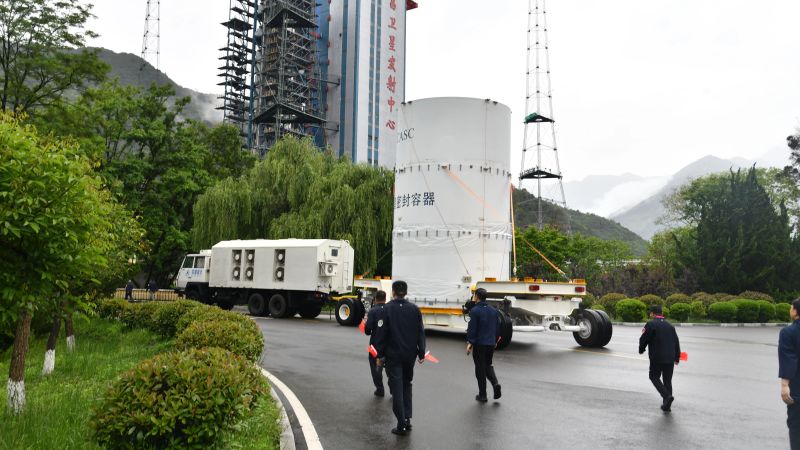In an exciting development for space exploration, China has embarked on its Tianwen-2 mission, aimed at studying two unique celestial bodies within our solar system. Unlike any previous mission, Tianwen-2 intends to visit objects that have not been encountered by spacecraft before. This endeavor marks a significant step in advancing our understanding of these lesser-known solar phenomena.
The mission was launched aboard a Long March 3B rocket from the Xichang Satellite Launch Center, located in Sichuan province, at 1:31 PM Eastern Time (1:31 AM, Thursday local time in China), as reported by the China National Space Administration. The Tianwen-2 mission shares its name and ambitious spirit with its predecessor, Tianwen-1, which successfully placed a rover and orbiter on Mars in July 2020. Like its predecessor, Tianwen-2 possesses two main objectives for the spacecraft to achieve.
The primary aim of this mission is to perform a flyby of and to collect samples from an asteroid known as Kamoʻoalewa, also referred to as asteroid 2016 HO3. Notably, this asteroid is posited to be a fragment ejected from the Moon, positioning it as a “quasi-satellite” that orbits closely around our planet. The spacecraft is projected to spend one year en route to Kamoʻoalewa, followed by an additional year mapping and determining suitable landing sites for sample collection.
Once the samples are retrieved and returned to Earth via a capsule approximately 2.5 years after launch, the mission will extend its focus to a secondary target—main belt comet 311P/Pan-STARRS. This intriguing object, known as an active asteroid, orbits between Mars and Jupiter, and exhibits comet-like tails as a result of dust production.
The significance of both Kamoʻoalewa and 311P/Pan-STARRS cannot be overstated, especially given that astronomers were largely unaware of such asteroid populations until recent discoveries. Dr. Teddy Kareta, a postdoctoral associate in planetary science at Lowell Observatory, noted the excitement of studying these objects up close, which offers a unique opportunity to understand their characteristics in a way previously thought unattainable. “It’s like opening presents on your birthday,” Kareta shared, highlighting the thrill of exploring new celestial objects.
Kamoʻoalewa was first identified in 2016 by astronomers using the Pan-STARRS telescope in Hawaii. Dr. Ben Sharkey, a visiting senior faculty specialist at the University of Maryland, led a study indicating that this compact asteroid, comparable in size to a Ferris wheel, could be a large boulder expelled from the Moon due to an impact. The name Kamoʻoalewa originates from a Hawaiian chant representing an offspring journeying alone.
Measuring approximately 150 to 190 feet (46 to 58 meters) in diameter, Kamoʻoalewa is expected to be the smallest asteroid ever explored by a spacecraft. Dr. Patrick Michel, a prominent researcher at the French National Centre for Scientific Research, elaborated on the challenges and fascination of such a small mission. Given its diminutive size, the probe’s successful orbit and landing require precision maneuvering, as even minor miscalculations could result in failure.
In addition to its scientific endeavors, the Tianwen-2 mission could reveal crucial information regarding potential threats posed by asteroids. For instance, Kamoʻoalewa is thought to resemble an object that caused the catastrophic Tunguska event in Siberia over a century ago—an important consideration for planetary defense strategies. A 98-foot-wide (30 meters) asteroid struck the Podkamennaya Tunguska River in 1908, devastating a vast area of Siberian forest.
Moreover, the mission’s second target, 311P/Pan-STARRS, presents an opportunity to explore active asteroids which, until recently, scientists did not suspect could generate comet-like tails. The exploration of this object may yield fundamental insights into the mechanisms driving such phenomena.
Overall, Tianwen-2 represents an important leap forward for China in the realm of space exploration. With its dual focus on Kamoʻoalewa and 311P/Pan-STARRS, this mission promises to enhance our understanding of our solar system and the objects that inhabit it. Kareta’s reflection on the unknown elements of this journey underscores the anticipation surrounding the discoveries and surprises that await scientists in the coming years, when the mission reaches its targets and returns data that will enrich our knowledge of celestial objects.



